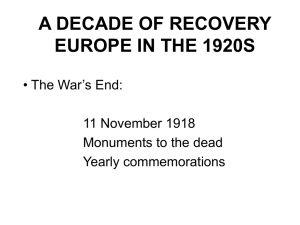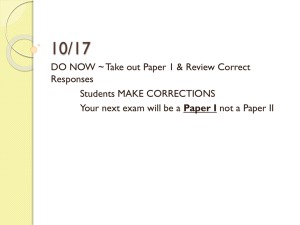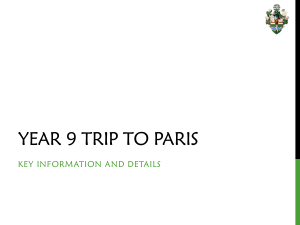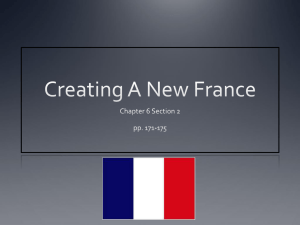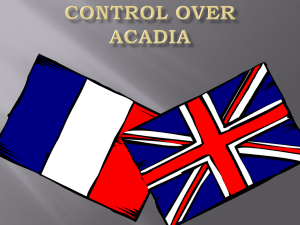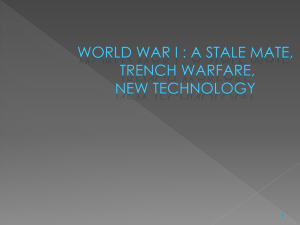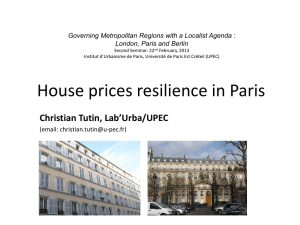10/7 & 10/8 League of Nations & collective security in
advertisement
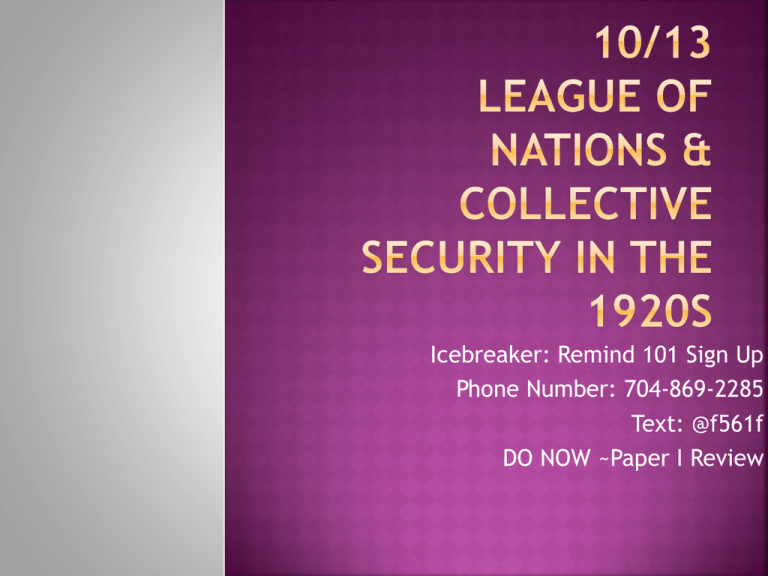
Icebreaker: Remind 101 Sign Up Phone Number: 704-869-2285 Text: @f561f DO NOW ~Paper I Review According to Source A which are Clemenceau’s points of view about justice towards the Germans? Can not be unreasonable towards Germans in fear of provoking the rise of nationalism Save the world from German aggression Justice must be served by the Germans What message is conveyed by Source E The Big Three have punished the Germans so much that the Treaty of Versailles will continue to effect the Germans for years to come Compare and contrast the views expressed about the Paris Peace Conference in sources C and D Similarities Both source C & D blame the leaders of the Paris Peace Conference of just worrying about their capitalist interests Treaties were forced on the people and not just Treaties created at Paris Peace Conference were a failure Differences Source D does agree to certain restrictions against Germany as long as Germany could recover economically Communist viewpoint did not support the idea of self – government or self – determination With reference to their origin and purpose, assess the value of limitations for historians studying the Paris Peace Conference of Source B & D Source B Origin – Hitler, Mein Kampf 1925 Purpose – Show resentment of Germany being forced to sign Treaty of Versailles Value – Hitler would go onto to be the leader of Germany in WWII and would use the Paris Peace Conference as a way to persuade the people to believe in his views Limitations – Does not show other leaders goals, beliefs, aims, etc. at the Paris Peace Conf. With reference to their origin and purpose, assess the value of limitations for historians studying the Paris Peace Conference of Source B & D Source D Origin – British delegate H. Nicolson at the Paris Peace Conference…book written ‘Peacemaking 1919’ Purpose – To report about the successes and failures at the Paris Peace Conference Value – H. Nicolson is a primary source because he attended the Paris Peace Conference and discusses the aims and goals when they arrived in Paris Limitation – Does not address the goals of other leaders especially the French who wanted to severely punish Germany “The Paris Peace Conference was guilty of disguising an imperialist peace under the surface of Wilsonism.” To what extend do you agree with Nicolson’s point of view. Agree Wilson & his 14 Points League of Nations Germans were held responsible for WWI (reparations, disarmament, etc.) Mandate System Britain wanted to protect its colonial empire Open Door Policy Problems ENFORCING peace treaties – USA did not join League of Nations = insecurity Disarmament difficult = NO TRUST France & Britain concerned about their own problems Italy & Japan looked to undermine the treaties signed and looked to gain land Some progress at fostering international cooperation Three important countries were not apart of the league: USA, Soviet Union, & Germany American politicians wanted to keep out of international affairs Bolshevik government was not recognized by the other Great Powers Germany was not allowed to join initially as one of the punishments imposed by the Treaty of Versailles. (Germany was a member from 19261933 Japan left in 1933 and Italy in 1937 A second fatal weakness was the fact that the League of Nations did not have an army. If a conflict arose, member states had to supply forces at their own expense. All were reluctant to do so, especially Britain and France who were effectively the only strong countries in the League. A third weakness was to do with organization. Each of the member countries sent delegates to the Assembly, but real power was concentrated in the hands of the Council, made up of permanent members Britain, France, Italy and Japan in 1920. Each member of the council had the right of veto, which meant that one vote against could stop action being agreed. Regarded the Treaty of Versailles as a ‘mutilated victory’ It did not gain all land it expected Felt Britain and France were determined to deny Italy equal treatment Social and economic problems let to political chaos 1922 King Victor Emmanuel asked Benito Mussolini to form a government Mussolini would set up a Fascist gov’t – based on the glory of the state and strength displayed through violence and conquest 1905 – defeat of Russia in Russo – Japanese War – gave Japan Korean Peninsula and control of railways in Manchuria Japan needed to import raw material and food Peace treaties angered Japanese due to terms not treating them as equals Japanese belief that they should control Pacific region and foreign influences like USA and Britain be removed Instability in China let to Japan willing to use military force to protect it’s interests Organized by U.S Naval arms race between U.S, U.K and Japan Called for 2 reasons: Cost of arms which no one could afford Defuse tension b/w U.S and Japan The Washington Naval Conference called by President Harding and held in Washington D.C. from Nov. 12 1921 to Feb. 6, 1922., it was attended by nine nations having interests in the pacific ocean and east Asia. Led to an effective end to building new battleship fleets and those few ships that were built were limited in size and armament. US, Britain, France, & Japan Result – December 1921 guaranteed the territorial rights to their respective possessions in the Pacific Agreed to defend each other in event of attack Signed February 1921 – Italy joined the alliance Result -= 5:5:3 Ratio size of their fleets USA, Britain, & Japan (France & Italy half the size of Japan) First steps towards international disarmament Expensive naval race avoided China’s political instability would result in foreign powers extending influence resulting in international conflict Confirmed Open Door Policy Washington Agreements Successful 1) Small number of countries = easier to find common ground 2) Countries could not afford naval cost Drafted to ensure the collective security of Europe Proposed sanctions against aggressors Members of the League would come to help any victim who fell to aggression French were enthusiastic about proposal Britain vetoed the proposal Held in Geneva, Switzerland, in 1927. Agreements made at the Washington Conference (1921-22), were largely confined to limitations on battleships and aircraft carriers. Talks dragged on for nearly six weeks during which tensions rose among the former Allies. In early August, the delegates adjourned without reaching any agreement. US secretary of state Frank Billings Kellogg & Aristide Briand (former minister of France) helped create a culture of disarmament Renounced the use of war and called for the peaceful settlement of disputes Pact was signed by 15 nations on August 27 1928 and in 1933 another 50 nations signed Despite optimism pact was little more then statement of good intentions 0 enforcement or binding clauses Please write down the following 3 Questions: What do you see in this cartoon? What is the message of the cartoonist? How do you know? Question Assessment Objective The first questions will test 1) Knowledge and understanding understanding of a source in part (a) ~ Understand historical sources and part (b) The second question will test analysis 1) Application and interpretation of sources through the comparison and ~ Compare and contrast historical contrast sources as evidence The third question will ask students to discuss two sources in relation to their origin, purpose, value, limitation 1) Synthesis & Evaluation ~ Evaluate historical sources as evidence The fourth question will test evaluation Knowledge & Understanding / of sources and context knowledge Application & Interpretation / Synthesis & Evaluation
